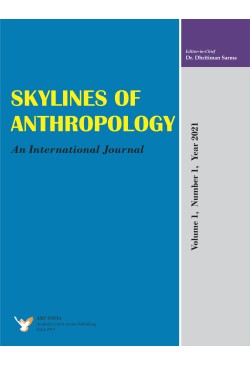
Skylines of Anthropology
Frequency :Bi-Annual
ISSN :2583-1402
Peer Reviewed Journal
Health Status of Tribal Adolescent Girls in Tribal Ashram Schools of Pune District, Maharashtra: A Comprehensive Study
Chaitali Choudhari, Shantanu Ozarkar & Sanjay Juvekar 2023. Health Status of Tribal Adolescent Girls in Tribal Ashram Schools of Pune District, Maharashtra: A Comprehensive Study. Skylines of Anthropology, 3: 2, pp. 73-82. https://doi.org/10.47509/SA.2023.v03i02.01
The Deity of the ‘Minors’: Sitala Puja in India- the Continuity of the Folk Traditions in Indian Culture
Sukanya Saha 2023. The Deity of the ‘Minors’: Sitala Puja in India-the Continuity of the Folk Traditions in Indian Culture. Skylines of Anthropology, 3: 2, pp. 83-98. https://doi.org/10.47509/SA.2023.v03i02.02
A Changing Continual Trends in Sumi Naga Village Establishment
Tovikali Yepthomi Sumi 2023. A Changing Continual Trends in Sumi Naga Village Establishment. Skylines of Anthropology, 3: 2, pp. 99-110. https://doi.org/10.47509/SA.2023.v03i02.03
Anthropometric Differences among the Tangkhuls Living in the Hill and Valley Region of Manipur
Background: Anthropometry and body composition analysis are important parameters to assess the health and fitness status of individuals. Studying the differences in anthropometry and body composition among populations can provide valuable insights into health disparities and inform targeted interventions to promote better health outcomes.
Aim: To examine the differences in anthropometric and body composition of the hill and valley Tangkhul males of Manipur.
Materials and Methods: In this cross-sectional study, 590 Tangkhul males were recruited through a random sampling method, with 350 participants from the hill and 240 from the valley. Body composition was assessed using the Drink water and Ross method of fractional masses. Anthropometric variables, blood pressure, and blood sugar were obtained following standardized procedures. Descriptive statistics and t-tests were employed to analyze the collected data.
Results: The findings revealed significant differences in the anthropometric measurements and body composition components of the two populations (p<0.05).
Conclusion: These outcomes suggest that the hill and valley Tangkhuls have regional variation in their anthropometric measurements, with the hill population displaying a more favorable body composition attributed to their healthier lifestyle and ecological setting.
Keywords: Anthropometric, Tangkhuls, hill, valley, body composition.
Urapam Zimik & Hosea Thanglen 2023. Anthropometric Differences among the Tangkhuls Living in the Hill and Valley Region of Manipur. Skylines of Anthropology, 3: 2, pp. 111-124. https://doi.org/10.47509/SA.2023.v03i02.04
The Drive to Recognise Indigenous Women Rights in the Face of a Putrefying Economy and Chronic Unemployment
Mawere J. & Tshamano W. 2023. The Drive to Recognise Indigenous Women Rights in the Face of a Putrefying Economy and Chronic Unemployment. Skylines of Anthropology, 3: 2, pp. 125-138. https://doi.org/10.47509/SA.2023.v03i02.05
Roles of Self Compassion, Emotion Regulation and Maladaptive Beliefs in Relationship Obsessive Compulsive Disorder
Mental health practitioners working with young people should routinely screen for ROCD among youth and conduct systematic, multi-method, and multi-informant assessments whenever symptoms are identified. The importance of research on ROCD can only be understood when costly behaviors such as ROCD become prevalent in a society, it affects the upbringing of a children, deteriorates the anxiety level in people especially the adolescent, and could lead to violence, traumatic expression over an event, psychotic behaviors. In this study, the independent variables are self-compassion, emotion regulation and maladaptive beliefs. The present study seeks to address the following research questions: Will self- compassion predict relationship obsessive compulsive disorder among married people? Will cognitive reappraisal predict relationship obsessive compulsive disorder among married people? Will expressive suppression predict relationship obsessive compulsive disorder among married people? Will maladaptive beliefs predict relationship obsessive compulsive disorder among married people? The purpose of the study is to explore and provide an understanding to the roles of self-compassion, emotion regulation and maladaptive belief in relationship obsessive compulsive disorder. The findings of the study show that self-compassion was a significantly positive predictor of relationship OCD. It also shows that the dimensions of emotion regulation (cognitive reappraisal and expressive suppression) did not significantly predict relationship OCD. If further proves that maladaptive beliefs positively predicted relationship OCD, showing that increased maladaptive beliefs was associated with increase in relationship OCD. Recommendations are discussed.
Keywords: Self Compassion, Emotion Regulation, Maladaptive Beliefs , Obsessive Compulsive Disorder
Beluonwu Ifeoma Margret, Ndubueze, Precious Chukwuamaka & Favour C. Uroko 2023. Roles of Self Compassion, Emotion Regulation and Maladaptive Beliefs in Relationship Obsessive Comulsive Disorder. Skylines of Anthropology, 3: 2, pp. 139-159 https://doi.org/10.47509/SA.2023.v03i02.06